+ Open data
Open data
- Basic information
Basic information
| Entry | Database: PDB / ID: 4r8x | ||||||
|---|---|---|---|---|---|---|---|
| Title | Crystal structure of a uricase from Bacillus fastidious | ||||||
 Components Components | Uricase | ||||||
 Keywords Keywords | HYDROLASE / Bacillus fastidious uricase / fold / stability | ||||||
| Function / homology |  Function and homology information Function and homology informationpurine nucleobase catabolic process / urate oxidase activity / factor-independent urate hydroxylase / urate catabolic process / peroxisome Similarity search - Function | ||||||
| Biological species |  Bacillus fastidiosus (bacteria) Bacillus fastidiosus (bacteria) | ||||||
| Method |  X-RAY DIFFRACTION / X-RAY DIFFRACTION /  SYNCHROTRON / SYNCHROTRON /  MOLECULAR REPLACEMENT / Resolution: 1.401 Å MOLECULAR REPLACEMENT / Resolution: 1.401 Å | ||||||
 Authors Authors | Feng, J. / Wang, L. / Liu, H.B. / Liu, L. / Liao, F. | ||||||
 Citation Citation |  Journal: Appl.Microbiol.Biotechnol. / Year: 2015 Journal: Appl.Microbiol.Biotechnol. / Year: 2015Title: Crystal structure of Bacillus fastidious uricase reveals an unexpected folding of the C-terminus residues crucial for thermostability under physiological conditions. Authors: Feng, J. / Wang, L. / Liu, H. / Yang, X. / Liu, L. / Xie, Y. / Liu, M. / Zhao, Y. / Li, X. / Wang, D. / Zhan, C.G. / Liao, F. | ||||||
| History |
|
- Structure visualization
Structure visualization
| Structure viewer | Molecule:  Molmil Molmil Jmol/JSmol Jmol/JSmol |
|---|
- Downloads & links
Downloads & links
- Download
Download
| PDBx/mmCIF format |  4r8x.cif.gz 4r8x.cif.gz | 572.9 KB | Display |  PDBx/mmCIF format PDBx/mmCIF format |
|---|---|---|---|---|
| PDB format |  pdb4r8x.ent.gz pdb4r8x.ent.gz | 478.2 KB | Display |  PDB format PDB format |
| PDBx/mmJSON format |  4r8x.json.gz 4r8x.json.gz | Tree view |  PDBx/mmJSON format PDBx/mmJSON format | |
| Others |  Other downloads Other downloads |
-Validation report
| Summary document |  4r8x_validation.pdf.gz 4r8x_validation.pdf.gz | 451.3 KB | Display |  wwPDB validaton report wwPDB validaton report |
|---|---|---|---|---|
| Full document |  4r8x_full_validation.pdf.gz 4r8x_full_validation.pdf.gz | 456.8 KB | Display | |
| Data in XML |  4r8x_validation.xml.gz 4r8x_validation.xml.gz | 62.3 KB | Display | |
| Data in CIF |  4r8x_validation.cif.gz 4r8x_validation.cif.gz | 98.4 KB | Display | |
| Arichive directory |  https://data.pdbj.org/pub/pdb/validation_reports/r8/4r8x https://data.pdbj.org/pub/pdb/validation_reports/r8/4r8x ftp://data.pdbj.org/pub/pdb/validation_reports/r8/4r8x ftp://data.pdbj.org/pub/pdb/validation_reports/r8/4r8x | HTTPS FTP |
-Related structure data
| Related structure data | 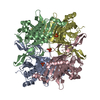 4r99C  1j2gS C: citing same article ( S: Starting model for refinement |
|---|---|
| Similar structure data |
- Links
Links
- Assembly
Assembly
| Deposited unit | 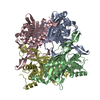
| ||||||||
|---|---|---|---|---|---|---|---|---|---|
| 1 |
| ||||||||
| Unit cell |
|
- Components
Components
| #1: Protein | Mass: 35859.809 Da / Num. of mol.: 4 Source method: isolated from a genetically manipulated source Source: (gene. exp.)  Bacillus fastidiosus (bacteria) / Production host: Bacillus fastidiosus (bacteria) / Production host:  References: UniProt: C5HDG5, 3-hydroxyisobutyryl-CoA hydrolase #2: Water | ChemComp-HOH / | |
|---|
-Experimental details
-Experiment
| Experiment | Method:  X-RAY DIFFRACTION / Number of used crystals: 1 X-RAY DIFFRACTION / Number of used crystals: 1 |
|---|
- Sample preparation
Sample preparation
| Crystal | Density Matthews: 2.46 Å3/Da / Density % sol: 50.05 % |
|---|---|
| Crystal grow | Temperature: 289 K / Method: vapor diffusion, sitting drop / pH: 8.5 Details: Tris, 20% PEG 3350, 0.2M sodium citrate, pH 8.5, VAPOR DIFFUSION, SITTING DROP, temperature 289K |
-Data collection
| Diffraction | Mean temperature: 100 K |
|---|---|
| Diffraction source | Source:  SYNCHROTRON / Site: SYNCHROTRON / Site:  SSRF SSRF  / Beamline: BL17U / Wavelength: 0.9793 Å / Beamline: BL17U / Wavelength: 0.9793 Å |
| Detector | Type: ADSC QUANTUM 315r / Detector: CCD / Date: Apr 10, 2012 |
| Radiation | Monochromator: double crystal / Protocol: SINGLE WAVELENGTH / Monochromatic (M) / Laue (L): M / Scattering type: x-ray |
| Radiation wavelength | Wavelength: 0.9793 Å / Relative weight: 1 |
| Reflection | Resolution: 1.4→50 Å / Num. all: 269102 / Num. obs: 256186 / % possible obs: 95.2 % / Biso Wilson estimate: 14.12 Å2 |
| Reflection shell | Resolution: 1.4→1.45 Å / % possible all: 93.1 |
- Processing
Processing
| Software |
| |||||||||||||||||||||||||||||||||||||||||||||||||||||||||||||||||||||||||||||||||||||||||||||||||||||||||||||||||||||||||||||||||||||||||||||||||||||||||||||||||||||||||||||||||||||||||||||||||||||||||||||||||||||||||
|---|---|---|---|---|---|---|---|---|---|---|---|---|---|---|---|---|---|---|---|---|---|---|---|---|---|---|---|---|---|---|---|---|---|---|---|---|---|---|---|---|---|---|---|---|---|---|---|---|---|---|---|---|---|---|---|---|---|---|---|---|---|---|---|---|---|---|---|---|---|---|---|---|---|---|---|---|---|---|---|---|---|---|---|---|---|---|---|---|---|---|---|---|---|---|---|---|---|---|---|---|---|---|---|---|---|---|---|---|---|---|---|---|---|---|---|---|---|---|---|---|---|---|---|---|---|---|---|---|---|---|---|---|---|---|---|---|---|---|---|---|---|---|---|---|---|---|---|---|---|---|---|---|---|---|---|---|---|---|---|---|---|---|---|---|---|---|---|---|---|---|---|---|---|---|---|---|---|---|---|---|---|---|---|---|---|---|---|---|---|---|---|---|---|---|---|---|---|---|---|---|---|---|---|---|---|---|---|---|---|---|---|---|---|---|---|---|---|---|
| Refinement | Method to determine structure:  MOLECULAR REPLACEMENT MOLECULAR REPLACEMENTStarting model: 1J2G Resolution: 1.401→32.039 Å / FOM work R set: 0.8645 / SU ML: 0.15 / σ(F): 1.96 / Phase error: 21.5 / Stereochemistry target values: ML
| |||||||||||||||||||||||||||||||||||||||||||||||||||||||||||||||||||||||||||||||||||||||||||||||||||||||||||||||||||||||||||||||||||||||||||||||||||||||||||||||||||||||||||||||||||||||||||||||||||||||||||||||||||||||||
| Solvent computation | Shrinkage radii: 0.9 Å / VDW probe radii: 1.11 Å / Solvent model: FLAT BULK SOLVENT MODEL | |||||||||||||||||||||||||||||||||||||||||||||||||||||||||||||||||||||||||||||||||||||||||||||||||||||||||||||||||||||||||||||||||||||||||||||||||||||||||||||||||||||||||||||||||||||||||||||||||||||||||||||||||||||||||
| Displacement parameters | Biso max: 72.08 Å2 / Biso mean: 19.22 Å2 / Biso min: 9.18 Å2 | |||||||||||||||||||||||||||||||||||||||||||||||||||||||||||||||||||||||||||||||||||||||||||||||||||||||||||||||||||||||||||||||||||||||||||||||||||||||||||||||||||||||||||||||||||||||||||||||||||||||||||||||||||||||||
| Refinement step | Cycle: LAST / Resolution: 1.401→32.039 Å
| |||||||||||||||||||||||||||||||||||||||||||||||||||||||||||||||||||||||||||||||||||||||||||||||||||||||||||||||||||||||||||||||||||||||||||||||||||||||||||||||||||||||||||||||||||||||||||||||||||||||||||||||||||||||||
| Refine LS restraints |
| |||||||||||||||||||||||||||||||||||||||||||||||||||||||||||||||||||||||||||||||||||||||||||||||||||||||||||||||||||||||||||||||||||||||||||||||||||||||||||||||||||||||||||||||||||||||||||||||||||||||||||||||||||||||||
| LS refinement shell | Refine-ID: X-RAY DIFFRACTION / Total num. of bins used: 30
|
 Movie
Movie Controller
Controller




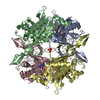

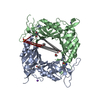

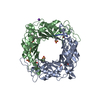
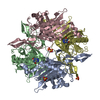
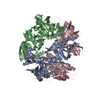
 PDBj
PDBj

